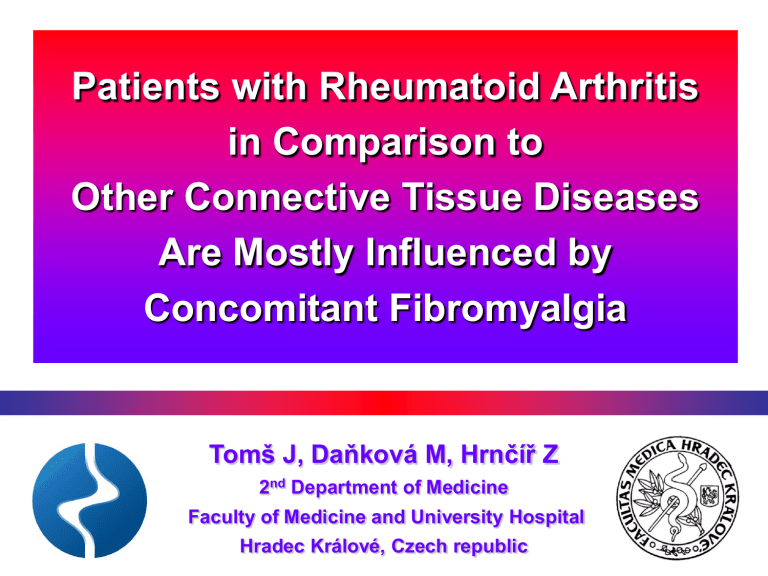
Patients with Rheumatoid Arthritis
in Comparison to
Other Connective Tissue Diseases
Are Mostly Influenced by
Concomitant Fibromyalgia
Tomš J, Daňková M, Hrnčíř Z
2nd Department of Medicine
Faculty of Medicine and University Hospital
Hradec Králové, Czech republic
Abstract
Background: A number of clinical studies documented that fibromyalgia (FM) can frequently accompany
connective tissue diseases (CTD) as a concomitant syndrome. There is a lack of data about
differencies in FM impact on individual CTD.
Objectives: To compare the impact of concomitant FM on CTD in terms of pain intensity, disease activity,
function disability and quality of life (QOL) in a regional, monocentric, cross-sectional study.
Methods: 120 consecutive patients (pts) with rheumatoid arthritis (RA), 91 pts with systemic lupus (SLE), 30
pts with polymyositis/dermatomyositis (PM/DM) and 30 pts with systemic sclerosis (SSc) were
examined in our outpatient rheumatology department on the presence of FM (ACR criteria,1990).
Standard Manual Tender Point Survey was used for the examination of FM tender points. The following
data were recorded: demographic data, tender point count (TPC), pain, fatigue and stiffness intensity
on a 100 mm visual analog scale (VAS), Fibromyalgia Impact Questionnarie (FIQ) score and disease
activity indices according to individual CTD representatives (DAS-28, SLEDAI, serum muscle
enzymes). Health Assessment Questionnarie (HAQ) and Short Form 36 items (SF-36) were used for
evaluation of functional disability and QOL, respectively. Statistical analysis was based on KruskalWallis nonparametric tests comparing mutually all the CTD cohorts with and without FM. Patient file with
SSc and FM was not included into the analysis due to small quantity.
Results: FM diagnosis was established in 25 (20.8%) pts with RA, 10 (11.0%) pts with SLE, 4 (13.3%) pts
with PM/DM and 1 patient with SSc (3.6%). CTD groups with concomitant FM were shown to have
significantly higher levels of pain, fatigue, stiffness, TPC and FIQ (p <0.05). RA/FM pts reached the
highest average intensity of pain (VAS pain 63.7 mm), the worst disability level (HAQ 1.832) and the
most reduced QOL in some of SF-36 domains. Disease activity assessment was significantly influenced
only in RA pts (DAS-28 in RA with and without FM 5.35 1.1 vs. 3.67 1.4; p < 0.0001).
Conclusion: Concomitant FM appears most frequently in pts with RA in comparison to other CTD. RA
patients are also mostly influenced by FM at the level of pain perception, disability and QOL. This FM
impact contributes to significant difficulties in RA disease activity assessment unlike other CTD.
Background and Objectives
Background
A number of clinical studies documented that fibromyalgia (FM) can frequently
accompany
connective tissue diseases (CTD) as a concomitant syndrome
(Table). There is a lack of data about differencies in FM impact on individual
CTD.
Frequency of
concomitant
fibromyalgia
in CTD (%)
Rheumatoid
arthritis
Systemic lupus
erythematodes
Poly-/ dermatomyositis
Systemic
sclerosis
Sjögren
syndrome
6.6 – 57.0
1.0 – 25.0
8,0 – 13.3
1.0 - 4.0
6.9 – 22.0
Objectives
To compare the impact of concomitant FM on connective tissue diseases
in terms of pain intensity, disease activity, fucntion disability and quality of
life in regional, monocentric, cross-sectional study.
Methods
• clinical examination of the patients with CTD attending outpatient rheumatology
department (terciary centre)
• diagnosis of RA according to the criteria ACR 1987, SLE according to the criteria
ACR 1982/1997, PM/DM according to Bohan´s and Peter´s criteria (1975),
SSc according to the criteria ACR 1980
• examination focused on the presence of FM according to the criteria ACR 1990
• FM tender point examination - the protocol MTPS (Standardised Manual
Tender Point Survey) Okifuji et al. J Rheumatol 1997;24:377-83
• disease activity - DAS-28, SLEDAI, creatinkinase (myoglobin)
• functional disability - HAQ (Health assessment questionnaire)
• quality of life - SF-36 (Short Form 36 items)
• FIQ (Fibromyalgia Impact Questionnaire)
• SDS (Zung´s self-rating depression scale)
• pain, fatigue and stiffness intenstity evaluated on a 100 mm horizontal visual
analogue scale (VAS)
• statistical analysis was based on Kruskal-Wallis nonparametric tests comparing
mutually all the CTD cohorts with and without FM
• patient file with SSc and FM was not included into the analysis due to small quantity
Patient groups
n
RA
SLE
120
91
PM/DM
30
SSc
30
(PM = 18, DM = 12)
Age
(years – median, range)
Sex ratio
(M : F)
Disease duration
(years – median, range)
Disease activity
57.0
(22 - 74)
43.0
(18 -75)
50.0
(19 - 74)
61.5
(41 - 76)
29 : 91
(24.2 : 75.8 %)
6 : 85
(6.6 : 93.4 %)
13 : 17
(43.3 : 56.7 %)
10 : 20
(33.3 : 66.6 %)
11.2
(0.1 - 57.1)
8.8
(0.3 - 36.0)
3.6
(0.3 - 21.0)
6.0
(1.0 - 25.0)
CK = 2.15 µkat/l
(0.55 – 30.9)
Not
DAS-28
4.02 ± 1.52
SLEDAI
3 (0 – 13)
Myogl = 50.1 µkat/l
(22.3 – 650.5)
Explanation: data of disease activity are median and 5th – 95th percentile
evaluated
Results I.
RA/FM-
RA/FM+
SLE/FM-
SLE/FM+
PDM/FM-
PDM/FM+
SSc/FM-
N
95
25
81
10
26
4
29
Age
(years)
55.9 ± 13.6
61.4 ± 10.7
43.0 ± 14.3
44.8 ± 9.7
48.5 ± 16.8
54.3 ± 11.5
61.9 ± 9.9
Sex ratio
(M : F)
25 : 70
4 : 21
6 : 75
0 : 10
13 : 13
0:4
10 : 19
Disease
duration
(years)
10.9 ± 9.1
12.8 ± 12.5
10.1 ± 7.8
11.1 ± 7.0
2,5
11.2
7.1 ± 5.2
CK = 2.00 µkat/l
(1.3 – 5.1)
CK = 2.20 µkat/l
(1.9 – 9.6)
Not
Myogl = 52.6 µkat/l
(30.0 – 135.0)
Myogl = 37,2 µkat/l
(27.0 – 96.0)
Disease
activity
*DAS-28
*DAS-28
3.67 ± 1.4
5.35 ± 1.1
SLEDAI
3 (0 – 13)
SLEDAI
3.5 (0 – 9.0)
Evaluated
Explanation: parameters characterized by more numbers: average ± standard deviation or median and5th-95th percentile
* Difference in DAS-28 is statistically significant:
p < 0.0001
Results II.
CTD groups with concomitant FM were shown to have significantly higher levels
of pain, fatigue, stiffness, TPC and FIQ (p <0.05).
RA/FM+ patients reached the highest average intensity of pain (VAS pain 63.7 mm).
70
60
RA/FM+
50
RA/FMSLE/FM+
40
SLE/FM-
30
PDM/FM+
20
PMD/FMSSc/FM-
10
0
VAS pain
VAS fatigue VAS stiffness
FIQ
TPC
Explanation: CTD – connective tissue diseases, VAS - visual analogue scale, FIQ – Fibromyalgia Impact Questionnaire, TPC – tender point count
Results III.
RA/FM+ patients reached the worst disability level (HAQ 1.832), p < 0.05,
and the highest depression score (SDS 0.508), p < 0.05.
2
1,8
1,6
1,4
1,2
1
0,8
0,6
0,4
0,2
0
RA/FM+
RA/FMSLE/FM+
SLE/FMPDM/FM+
PMD/FMSSc/FM-
HAQ
SDS
Explanation: HAQ - Health Assessment Questionnaire, SDS – Zung´s depression self-rating scale
Results IV.
PF
80
Short Form 36 items (SF-36)
70
MH
60
RP
50
40
RA/FM+
30
RA/FM-
20
10
RE
SLE/FM+
BP
0
SLE/FMPDM/FM+
PMD/FM-
SF
GH
p < 0,001
VT
Values on individual axes are mean scores of quality of life domains.
PF – physical functioning, RP – role physical, BP – bodily pain, GH – General health,
VT – vitality, SF – social functioning, RE - role emotoinal, MH – mental health.
Disease Activity in Rheumatoid arthritis
Components of DAS-28 index
p < 0.0001
Count (or mm)
60
p = 0.438
50
40
30
RA
p < 0.0001
RA/FM
20
p = 0.022
10
0
TJC
SJC
FW
Pain - VAS
Explanation: DAS-28 – disease activity score evaluating 28 joints, TJC – tender joint count,
SJC – swollen joint count, FW – erythrosite sedimentation rate, VAS - visual analogue scale
1
7
80%
17
60%
36
45
40%
14
20%
0%
< 3,2
3,2 - 5,1
> 5,1
RAF+
1
7
17
RAF-
36
45
14
Relativnicount
cetnost
Relative
40,0
20,0
0,0
0,0
DAS-28
60,0
60,0
R elativni cetnost
count
Relative
%
count
Relative
Relativní
četnost
(%)
100%
1,0
2,0
3,0
4,0
5,0
DAS_28_RA
6,0
7,0
8,0
40,0
20,0
0,0
0,0
1,0
2,0
3,0
4,0
5,0
DAS_28_FM
6,0
7,0
8,0
Conclusion
• concomitant fibromyalgia appears most frequently
in patients with rheumatoid arthritis in comparison
to other connective tissue disease
• RA patients are mostly influenced by FM at the level
of pain perception, disability and in some domains of life
quality
• FM impact contributes to significant difficulties in RA
disease activity assessment unlike other connective
tissue diseases











